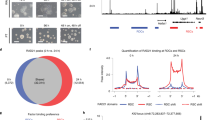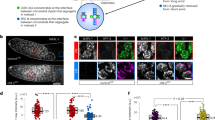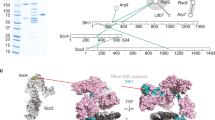Abstract
Mammalian genomes contain several billion base pairs of DNA that are packaged in chromatin fibres. At selected gene loci, cohesin complexes have been proposed to arrange these fibres into higher-order structures1,2,3,4,5,6,7, but how important this function is for determining overall chromosome architecture and how the process is regulated are not well understood. Using conditional mutagenesis in the mouse, here we show that depletion of the cohesin-associated protein Wapl8,9 stably locks cohesin on DNA, leads to clustering of cohesin in axial structures, and causes chromatin condensation in interphase chromosomes. These findings reveal that the stability of cohesin–DNA interactions is an important determinant of chromatin structure, and indicate that cohesin has an architectural role in interphase chromosome territories. Furthermore, we show that regulation of cohesin–DNA interactions by Wapl is important for embryonic development, expression of genes such as c-myc (also known as Myc), and cell cycle progression. In mitosis, Wapl-mediated release of cohesin from DNA is essential for proper chromosome segregation and protects cohesin from cleavage by the protease separase, thus enabling mitotic exit in the presence of functional cohesin complexes.
This is a preview of subscription content, access via your institution
Access options
Subscribe to this journal
Receive 51 print issues and online access
$199.00 per year
only $3.90 per issue
Buy this article
- Purchase on Springer Link
- Instant access to full article PDF
Prices may be subject to local taxes which are calculated during checkout




Similar content being viewed by others
Accession codes
Accessions
Gene Expression Omnibus
Data deposits
ChiP-seq and microarray data have been deposited in the GEO database (http://www.ncbi.nlm.nih.gov/geo) under accession code GSE41603.
References
Hadjur, S. et al. Cohesins form chromosomal cis-interactions at the developmentally regulated IFNG locus. Nature 460, 410–413 (2009)
Mishiro, T. et al. Architectural roles of multiple chromatin insulators at the human apolipoprotein gene cluster. EMBO J. 28, 1234–1245 (2009)
Nativio, R. et al. Cohesin is required for higher-order chromatin conformation at the imprinted IGF2–H19 locus. PLoS Genet. 5, e1000739 (2009)
Kagey, M. H. et al. Mediator and cohesin connect gene expression and chromatin architecture. Nature 467, 430–435 (2010)
Seitan, V. C. et al. A role for cohesin in T-cell-receptor rearrangement and thymocyte differentiation. Nature 476, 467–471 (2011)
DeMare, L. E. et al. The genomic landscape of cohesin-associated chromatin interactions. Genome Res. http://dx.doi.org/10.1101/gr.156570.113 (23 May 2013)
Phillips-Cremins, J. E. et al. Architectural protein subclasses shape 3D organization of genomes during lineage commitment. Cell 153, 1281–1295 (2013)
Gandhi, R., Gillespie, P. J. & Hirano, T. Human Wapl is a cohesin-binding protein that promotes sister-chromatid resolution in mitotic prophase. Curr. Biol. 16, 2406–2417 (2006)
Kueng, S. et al. Wapl controls the dynamic association of cohesin with chromatin. Cell 127, 955–967 (2006)
Peters, J. M., Tedeschi, A. & Schmitz, J. The cohesin complex and its roles in chromosome biology. Genes Dev. 22, 3089–3114 (2008)
Haering, C. H., Farcas, A. M., Arumugam, P., Metson, J. & Nasmyth, K. The cohesin ring concatenates sister DNA molecules. Nature 454, 297–301 (2008)
Chan, K. L. et al. Cohesin’s DNA exit gate is distinct from its entrance gate and is regulated by acetylation. Cell 150, 961–974 (2012)
Buheitel, J. & Stemmann, O. Prophase pathway-dependent removal of cohesin from human chromosomes requires opening of the Smc3-Scc1 gate. EMBO J. 32, 666–676 (2013)
Uhlmann, F., Lottspeich, F. & Nasmyth, K. Sister-chromatid separation at anaphase onset is promoted by cleavage of the cohesin subunit Scc1. Nature 400, 37–42 (1999)
Waizenegger, I. C., Hauf, S., Meinke, A. & Peters, J. M. Two distinct pathways remove mammalian cohesin from chromosome arms in prophase and from centromeres in anaphase. Cell 103, 399–410 (2000)
Hauf, S., Waizenegger, I. C. & Peters, J. M. Cohesin cleavage by separase required for anaphase and cytokinesis in human cells. Science 293, 1320–1323 (2001)
Kumada, K. et al. The selective continued linkage of centromeres from mitosis to interphase in the absence of mammalian separase. J. Cell Biol. 172, 835–846 (2006)
Wirth, K. G. et al. Separase: a universal trigger for sister chromatid disjunction but not chromosome cycle progression. J. Cell Biol. 172, 847–860 (2006)
Seitan, V. C. & Merkenschlager, M. Cohesin and chromatin organisation. Curr. Opin. Genet. Dev. 22, 93–100 (2012)
Nishiyama, T. et al. Sororin mediates sister chromatid cohesion by antagonizing Wapl. Cell 143, 737–749 (2010)
Schmitz, J., Watrin, E., Lenart, P., Mechtler, K. & Peters, J. M. Sororin is required for stable binding of cohesin to chromatin and for sister chromatid cohesion in interphase. Curr. Biol. 17, 630–636 (2007)
Wang, L. H., Mayer, B., Stemmann, O. & Nigg, E. A. Centromere DNA decatenation depends on cohesin removal and is required for mammalian cell division. J. Cell Sci. 123, 806–813 (2010)
Farcas, A. M., Uluocak, P., Helmhart, W. & Nasmyth, K. Cohesin’s concatenation of sister DNAs maintains their intertwining. Mol. Cell 44, 97–107 (2011)
Chan, K. L. & Hickson, I. D. New insights into the formation and resolution of ultra-fine anaphase bridges. Semin. Cell Dev. Biol. 22, 906–912 (2011)
Sun, Y. et al. Separase is recruited to mitotic chromosomes to dissolve sister chromatid cohesion in a DNA-dependent manner. Cell 137, 123–132 (2009)
Vernì, F., Gandhi, R., Goldberg, M. L. & Gatti, M. Genetic and molecular analysis of wings apart-like (wapl), a gene controlling heterochromatin organization in Drosophila melanogaster. Genetics 154, 1693–1710 (2000)
Guacci, V. & Koshland, D. Cohesin-independent segregation of sister chromatids in budding yeast. Mol. Biol. Cell 23, 729–739 (2012)
Lopez-Serra, L., Lengronne, A., Borges, V., Kelly, G. & Uhlmann, F. Budding yeast Wapl controls sister chromatid cohesion maintenance and chromosome condensation. Curr. Biol. 23, 64–69 (2013)
Pezzi, N. et al. STAG3, a novel gene encoding a protein involved in meiotic chromosome pairing and location of STAG3-related genes flanking the Williams– Beuren syndrome deletion. FASEB J. 14, 581–592 (2000)
Ono, T. et al. Differential contributions of condensin I and condensin II to mitotic chromosome architecture in vertebrate cells. Cell 115, 109–121 (2003)
Rodríguez, C. I. et al. High-efficiency deleter mice show that FLPe is an alternative to Cre-loxP. Nature Genet. 25, 139–140 (2000)
Tallquist, M. D. & Soriano, P. Epiblast-restricted Cre expression in MORE mice: a tool to distinguish embryonic vs. extra-embryonic gene function. Genesis 26, 113–115 (2000)
Seibler, J. et al. Rapid generation of inducible mouse mutants. Nucleic Acids Res. 31, e12 (2003)
Hadjantonakis, A. K. & Papaioannou, V. E. Dynamic in vivo imaging and cell tracking using a histone fluorescent protein fusion in mice. BMC Biotechnol. 4, 33 (2004)
Poser, I. et al. BAC TransgeneOmics: a high-throughput method for exploration of protein function in mammals. Nature Methods 5, 409–415 (2008)
Hauf, S. et al. The small molecule Hesperadin reveals a role for Aurora B in correcting kinetochore-microtubule attachment and in maintaining the spindle assembly checkpoint. J. Cell Biol. 161, 281–294 (2003)
Zuber, J. et al. RNAi screen identifies Brd4 as a therapeutic target in acute myeloid leukaemia. Nature 478, 524–528 (2011)
Schermelleh, L., Solovei, I., Zink, D. & Cremer, T. Two-color fluorescence labeling of early and mid-to-late replicating chromatin in living cells. Chromosome Res. 9, 77–80 (2001)
Zink, D. et al. Structure and dynamics of human interphase chromosome territories in vivo. Hum. Genet. 102, 241–251 (1998)
Stedman, W. et al. Cohesins localize with CTCF at the KSHV latency control region and at cellular c-myc and H19/Igf2 insulators. EMBO J. 27, 654–666 (2008)
Wendt, K. S. et al. Cohesin mediates transcriptional insulation by CCCTC-binding factor. Nature 451, 796–801 (2008)
Bugler, B., Schmitt, E., Aressy, B. & Ducommun, B. Unscheduled expression of CDC25B in S-phase leads to replicative stress and DNA damage. Mol. Cancer 9, 29 (2010)
Cerqueira, A. et al. Overall Cdk activity modulates the DNA damage response in mammalian cells. J. Cell Biol. 187, 773–780 (2009)
Gerlich, D., Koch, B., Dupeux, F., Peters, J. M. & Ellenberg, J. Live-cell imaging reveals a stable cohesin–chromatin interaction after but not before DNA replication. Curr. Biol. 16, 1571–1578 (2006)
Schneider, C. A., Rasband, W. S. & Eliceiri, K. W. NIH Image to ImageJ: 25 years of image analysis. Nature Methods 9, 671–675 (2012)
Acknowledgements
We dedicate this paper to the memory of B. Peters, who performed the first experiments on Wapl in our laboratory. We are grateful to K. Aumayr, O. F.-Capetillo, T. Hoffmann, M. E. Idarraga-Amado, S. Kueng, T. Kulcsar, M. Leeb, P. Pasierbek, D. Santamaría, G. Schmauss, A. Souabni, H. Tkadletz, K. Wendt and members of the Peters laboratory for discussions and assistance, J. Hutchins for suggesting the term vermicelli, K. Nasmyth for the separase mouse model, and M. Barbacid, T. Cremer, T. Hirano, T. Jenuwein, M. Malumbres and J. Zuber for reagents. T.N. was supported by the European Molecular Biology Organization (EMBO) and the Japanese Society for the Promotion of Science (JSPS). S.H. was supported by funds from the Agence National de la Recherche (JCJC-SVSE2-2011, ChromaTranscript project) and the European Union (FP7-PEOPLE-2011-CIG, ChromaTranscript project). D.A.C. was supported by MFPL VIPS Program (BMWF and City of Vienna). A.V. acknowledges financial support by the Vienna Science and Technology Fund (WWTF) project VRG10-11, the Research Platform Quantum Phenomena and Nanoscale Biological Systems (QuNaBioS) and by Boehringer Ingelheim. Research in the laboratory of J.-M.P. is supported by Boehringer Ingelheim, the Austrian Science Fund (FWF special research program SFB F34 ‘Chromosome Dynamics’, and Wittgenstein award Z196-B20), the Austrian Research Promotion Agency (FFG, Laura Bassi Center for Optimized Structural Studies), the Vienna Science and Technology Fund (WWTF LS09-13), and the European Community’s Seventh Framework Programme (FP7/2007-2013) under grant agreement no. 241548 (MitoSys).
Author information
Authors and Affiliations
Contributions
Experiments were designed and data interpreted by A.T., G.W., S.H., M.J., J.E. and J.-M.P. A.T. generated Waplfl embryonic stem cells, established and maintained the mouse colony required for this study, and carried out chromosome segregation, transcriptome and ChIP-seq studies. A.T. and G.W. analysed cohesin localization by IFM, and cleavage of Scc1 in anaphase MEFs. G.W. generated MEFs expressing Scc1–LAP and Scc1–9myc, and carried out cohesin IFM experiments in telophase and G1-phase MEFs. G.W. and V.B. performed chromatin fractionation experiments. G.W. and T.N. performed cleavage assays of Scc1 with Xenopus egg extracts. A.T., G.W. and W.T analysed cell cycle progression of MEFs. S.H. performed DNA granularity analysis and Cy3-dUTP labelling of DNA. M.J. carried out bioinformatic analyses. A.Wue. performed cohesin FRAP experiments. E.S. performed FISH experiments. A.Wut. supervised the work of A.T. with embryonic stem cells, and participated in designing the Wapl targeting strategy. I.F.D. performed replication assays with Xenopus egg extracts. D.A.C. performed live imaging of cohesin vermicelli under the guidance of A.V. A.T. and J.-M.P. wrote the manuscript.
Corresponding author
Ethics declarations
Competing interests
The authors declare no competing financial interests.
Supplementary information
Supplementary Information
This file contains Supplementary Figures 1-18, Supplementary Methods, additional references and primer sequences for Supplementary figure 11. (PDF 2113 kb)
Rights and permissions
About this article
Cite this article
Tedeschi, A., Wutz, G., Huet, S. et al. Wapl is an essential regulator of chromatin structure and chromosome segregation. Nature 501, 564–568 (2013). https://doi.org/10.1038/nature12471
Received:
Accepted:
Published:
Issue Date:
DOI: https://doi.org/10.1038/nature12471
This article is cited by
-
Oncogenic c-Myc induces replication stress by increasing cohesins chromatin occupancy in a CTCF-dependent manner
Nature Communications (2024)
-
RAD21 is the core subunit of the cohesin complex involved in directing genome organization
Genome Biology (2023)
-
Loss of cohesin regulator PDS5A reveals repressive role of Polycomb loops
Nature Communications (2023)
-
Genome control by SMC complexes
Nature Reviews Molecular Cell Biology (2023)
-
Context-dependent perturbations in chromatin folding and the transcriptome by cohesin and related factors
Nature Communications (2023)
Comments
By submitting a comment you agree to abide by our Terms and Community Guidelines. If you find something abusive or that does not comply with our terms or guidelines please flag it as inappropriate.



